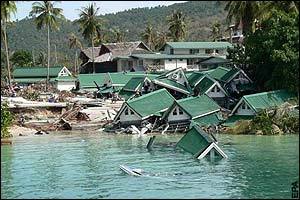The quake of magnitude 8 to 8.5 on 21 July of AD 365 claimed the lives of thousands of people in Alexandria alone and lifted a 200 mile stretch of the coastline of western Crete by up to 10 metres above sea level, tilting Crete to the north east.
Today, a Cambridge University team says it was surprised to find that this giant 10 metre uplift occurred in one go.
Morever, it has found that similar quakes could strike in as little as 800 years as stresses and strains build up in the seabed.
The study by Beth Shaw and her colleagues in the journal Nature Geoscience presents a fresh analysis of the Mediterranean seafloor, and suggests that a previously overlooked fault could be the source of the large earthquake that caused the destruction of AD365.

|
| ©Telegraph UK |
| A Cambridge University team believes that the Mediterranean could be at risk from a devastating tsunami |
Earthquakes happen when rocks break along faults to jerk the sea floor upwards. This can occur when plates of the Earth's cracked crust collide.
In the eastern Mediterranean, tsunamis can occur due to earthquakes caused by the African Plate drifting northwards underneath Eurasia.
On average, one disastrous tsunami takes place in the Mediterranean region every 100 years, but there have been no large events in the last century and there have been nowhere near enough earthquakes in the eastern Mediterranean to accommodate the motion between Africa and Eurasia.
However, Ms Shaw says that by analysing evidence of previous sea levels she and her team found that, unlike in Sumatra, where one fault slips frequently in large earthquakes, "here, two fault systems accommodate the motion. One fault is lubricated, slipping quietly without earthquakes, whereas the other slips infrequently in large earthquakes which can cause tsunamis."
The scientists conclude that although the fault that lies between Eurasia and the down-going African ocean floor does not normally generate earthquakes, a separate fault which comes to the surface closer to Crete is capable of producing rare and very large earthquakes that can set off a tsunami.
"When we calculate the tsunami that would result from the uplift of the sea-floor if this second fault slipped in an earthquake, we find that it inundates Alexandria, southern Greece, Sicily, and travels up the Adriatic to Dubrovnik, as described in the historical record," says Ms Shaw.
The quake on 21 July 365 AD caused destruction in Alexandria, flooded coastal regions from the Nile Delta to Dubrovnik and drowned thousands of people.
Ammianus Marcellinus, writing after AD 378, provides a vivid account: "solid earth was shaken and trembled, the sea with its rolling waves was driven back and withdrew from the land... Hence, many ships were stranded as if on dry land, and since many men roamed without fear in the little that remained of the waters, to gather fish and similar things with their hands, the roaring sea, resenting this forced retreat, rose in its turn; and over the boiling shoals it dashed mightily upon islands and broad stretches of the mainland, and levelled innumerable buildings in the cities and wherever else they are to be found; so that amid the mad discord of the elements the altered face of the earth revealed marvelous sights.
"For the great mass of waters, returning when it was least expected, killed many thousands of men by drowning ..."
Sozomenes, writing in AD 439, says: "A great calamity struck the Alexandrians in Egypt, when the sea receded and then overflowed with such force that it flooded much of the dry land, so that even sea-going boats were found on roof-tops, carried there by the water.
"Indeed the day on which these things happened they call the anniversary of the earthquake, so that even now the Alexandrians keep a yearly festival."
Even today, the remains of a Roman harbour at Phalasarna, Crete, can be seen 6m above sea level. In all, 10 percent of all tsunamis worldwide occur in the Mediterranean.



Reader Comments
to our Newsletter